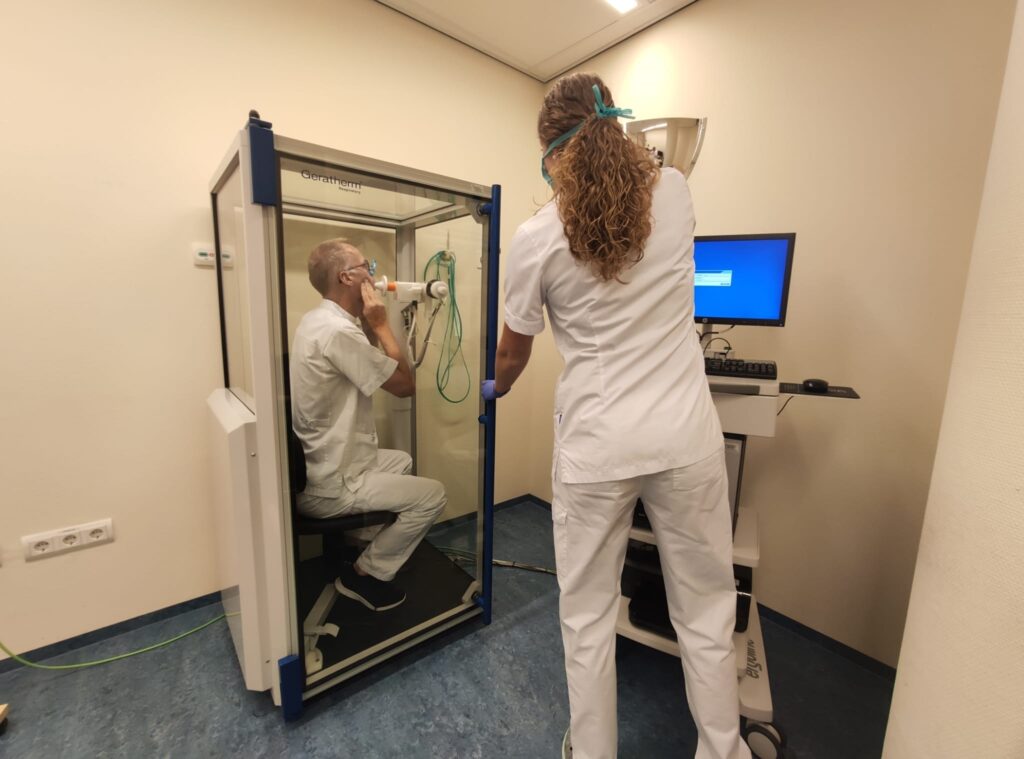Testing your lungs: lung volume tests
Lung volume tests measure how big your lungs are and can help your healthcare professional to understand how well your lungs are working. To do the test, you will need to breathe into a mouthpiece for several breaths or for several minutes.
Content Table
When will I be tested?
Your healthcare professional will refer you for the test if they need to learn more about how well your lungs are working. If you have questions about your lung health or lung volume tests, you will need to speak to your healthcare provider.
What happens during the test?
There are different ways to measure your lung volume. Each of these methods is designed to measure your:
- Total Lung Capacity (TLC) – the maximum amount of air you can breathe in.
- Residual Volume (RV) – the amount of air that is left in your lungs after you breathe out completely.
Body box methods
You will be asked to sit in a “phone box” – sized, clear booth, called a body box. You will breathe through a mouthpiece into a machine that will measure your breathing. While you are sitting in the box, the door will be closed. You may be asked to “pant” gently while pressing the palms of your hands against your cheeks. While breathing, a valve is closed for a few seconds. You will be asked to breathe against the closed valve. You will also be asked to take some deep breaths during the test.
Washout or gas dilution methods
You will be asked to breathe normally for several minutes while connected to a machine designed to measure your breathing. You will breathe through a mouthpiece and have a peg on your nose. The test usually lasts about 3-4 minutes but may take slightly longer. You will also be asked to take some deep breaths during the test.
What problems might occur during the test?
These tests are usually very easy to perform, but there are some things that you may find difficult at first. Some people can feel uncomfortable while performing the body box lung volume test because of the small space. You can open the door at any time. If you feel too uncomfortable, let the operator know as there may be other tests that can be used. Breathing against a closed valve may feel strange, however this only lasts a couple of seconds.
Understanding your results
Your healthcare professional will compare your results to what is considered normal for a person of your age, height, sex and ethnicity.
Your total lung capacity results might be higher or lower than for a person with healthy lungs. Total lung capacity may be higher if a large amount of air is ‘trapped’ in your lungs. Your total lung capacity may be lower if something is stopping you from being able to take in a full breath.
Your healthcare professional will explain the results of your lung volume test. Your residual volume may be higher if you have obstructed, or blocked, airways. This may be a sign of a condition such as emphysema or chronic bronchitis. The residual volume may be lower if you cannot expand your lungs fully. This could be caused by conditions that affect your chest wall or muscles, or the stiffness of your lungs, because of a specific disease. Sometimes the therapy used to treat a disease (drugs, chemotherapy, radiation therapy, etc.) can cause scarring that reduces the residual volume.
You may have lung disease, even if your lung volume is within the normal range. You may have symptoms such as a cough or breathlessness caused by smoking or other irritants that have not caused changes in your lung volume. These tests measure lung size but may not uncover diseases such as cancer. If you smoke, or breathe in harmful substances like dust, smoke, fumes or chemicals at work, and your results are normal, you are still at higher risk of different lung conditions and should do as much as you can to protect your lungs.
It is never too late to give up smoking, and there is support available – ask your healthcare professional how they can help you to quit. The European Lung Foundation website (www.europeanlung.org) has lots of information about the benefits of quitting smoking, which you can download in a range of languages, so this could be a good place to start.
Further reading
This factsheet was produced with the Global Lung Function Initiative.
Click the link above to learn more about the Global Lung Function Initiative, through which a group of researchers and clinicians are developing reference values for lung function tests to make sure that your test result is accurate, by collecting information on lung function from a large number of people from around the world.
European Lung Foundation: for more information on lung conditions and how to look after your lungs.
Healthy Lungs for Life: for more information about the Healthy Lungs for Life campaign and the importance of clean air, physical activity and stopping smoking for your lungs.




